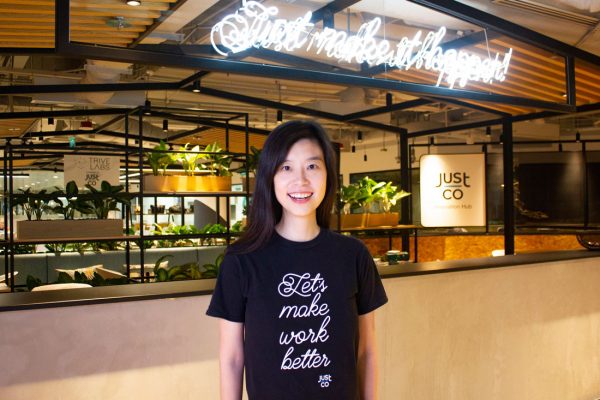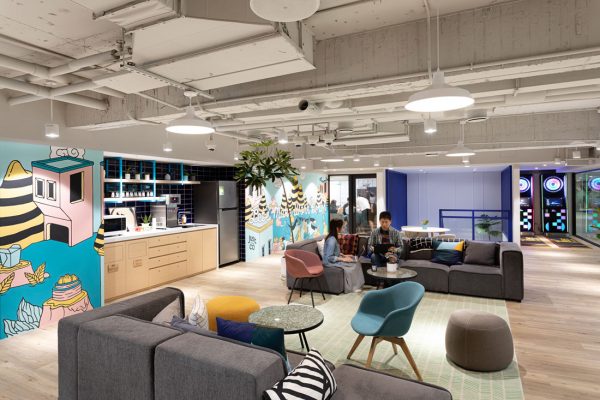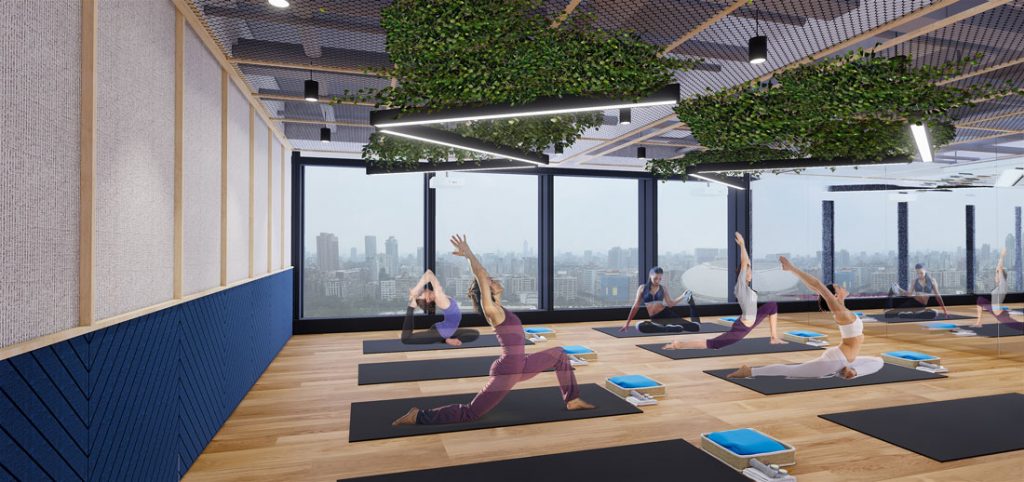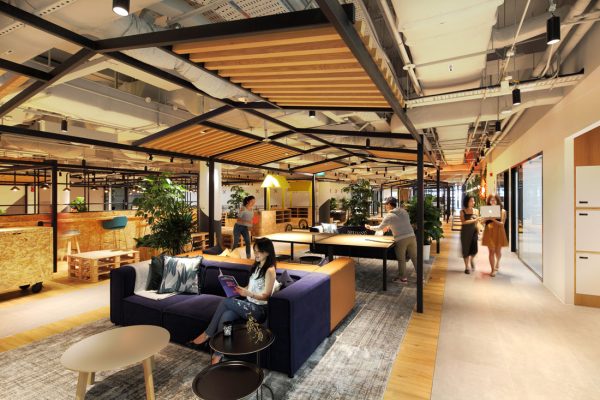JustCo Co-founder and COO Lu Liu talks about the coworking brand’s rapid expansion in the Asia Pacific region and the new challenges and opportunities that come with it.

October 25th, 2019
The year 2019 has been a very busy year for coworking brand JustCo. In the last three years, JustCo’s square footage has tripled. It won the heart of property developer giants GIC and Frasers last year, who came in as investors. This year, it expanded to Taiwan and Australia.
Today, it operates 38 coworking centres in eight cities across the Asia Pacific, with and has a growing list of large enterprise clients with bespoke demands that has made it necessary to form its own in-house design team. JustCo Co-Founder Lu Liu shares more:

Lu Liu
JustCo has expanded to Taiwan and Australia. Can you share more about the design concepts of JustCo location in these countries? What makes them unique and how do they fit in the working culture in the city?
We tried to have a consistent design DNA in every JustCo locations make our members feel comfortable and at home when they recognise the JustCo identity in whichever location they go. At the same time, we try to inject some local elements.
In JustCo Centre in Hung Tai Financial tower in Taiwan, for example, we commissioned local artists for the murals which revolve around two themes: local food and scenery.

On a deeper level, Taiwan as a country, in general, has made more efforts to be environmentally friendly, so we have introduced more recycled materials in the interior in partnership with MINIWIZ. Our design team got in touch with them – they’ve been around for 16 years and headquartered in Taipei – and we saw that their products are very versatile and applicable.
We use MINIWIZ’s recycled Polli-ber Bricks for the backdrop of the reception counter and many other interior elements throughout the centre like the coffee tables and the upholstery for the furniture.
Australians like to conduct their business in a casual setting. So we designed spacious common areas, especially the cafe so they can comfortably meet over coffee in the centre.
We’re very proud that we are the only Asian coworking operator with a multi-city presence in Asia. We’re in Singapore, Seoul, Taipei, Jakarta, Bangkok, Sydney, Melbourne, Shanghai – eight cities, so we have the network offering in this region. And with GIC and Frasers’ backing, we’ve started expanding more aggressively.
Coworking needs to have large communities and diverse partners to offer to their members so expanding the scale will be our priority in the next few years in the markets that we’ve entered.
But getting people through the door is only the first step. The next one is how to retain them with a great customer journey. We make sure we listen to our customers via one on one meeting as well as surveys to find out how we can improve and create the most productive experience for them, from adjusting the design elements to the choices of tea in the pantry.

JustCo Centre Minsheng Jianguo, Taipei
Siren Design has been your design partner since 2015 but you also have an in-house design team. Tell me more about that.
Our in-house design team was formed this year and they are mainly here to cater to our enterprise clients. We’ve had Fortune 500 companies joining us since last year. Big companies that have been with us and needed space for 30-50 people in their first years and would like to take our space as is.
Then they grew into 100-200 people, and sometimes they have the entire floor, and they would like a bespoke design, that’s where the in-house design team come in. They work with the client’s design team and design guidelines and take care of the submission within the allocated turnaround time, which sometimes is very tight.
We started with five people in the team, and today we have ten because of the demand from clients such as GE and Wilson Associates.
We start with the layout; it’s all about efficiency. We have a system to figure out the optimum number of hot desks versus private studios, how much to dedicate to common area versus the private area. We create our brief with this then we involve our design partner Siren Design and in some locations also a local designer.

JustCo Centre Dian Shih, Taipei
First is getting the prime real estate in the markets we’re in. Both GIC and Frasers are heavyweight property developers who have helped us to enter the China, Korea and Thailand markets.
The second biggest challenge is localisation. I’ve mentioned the different design, but we also adjust the customer service. We always hire a local GM who speaks the local language from relevant sectors and a sales and marketing team of local talents as well.
The third one is standardisation. As much as we need localisation, we also need to make sure that we have consistency in terms of our service delivery. Like Starbucks might tweak its menu according to countries, but the quality of the coffee is consistent.
That’s why we have a department called the Centre of Excellence, which consists of trainers. They have been with us for a long time and live and breathe JustCo DNA. They do the training for local teams for a few months in each location.
A few factors. Firstly, the overall economics – whether there is enough demand. Secondly, future potential. Like Jakarta, the city does not necessarily have all the money today but we a lot of potential because it has a robust, young tech sector.

JustCo Marina Square, Singapore
One is definitely the enterprise clients. We’ve always seen the demand, but these days they’re coming in big. They want huge spaces for proper headquarters, not just a rep office, which needed to be designed according to their corporate needs and identity.
We’ve also seen a diversification of our members, with more companies from, let’s call it traditional, sectors joining us, like accounting firms, which generally are not associated with the types of creatives companies that choose a coworking space as their office.
We have also partnered with schools like the Columbia business school and SMU so their students and alumni can come in and use the hot desks. These partnerships started with hosting the school for events. We’re very open to partnering with other schools and other companies that will add vibrancy to our community.
A searchable and comprehensive guide for specifying leading products and their suppliers
Keep up to date with the latest and greatest from our industry BFF's!

BLANCO launches their latest finish for a sleek kitchen feel.

Elevate any space with statement lighting to illuminate and inspire.

Within the intimate confines of compact living, where space is at a premium, efficiency is critical and dining out often trumps home cooking, Gaggenau’s 400 Series Culinary Drawer proves that limited space can, in fact, unlock unlimited culinary possibilities.

To honour Chef James Won’s appointment as Gaggenau’s first Malaysian Culinary Partner, we asked the gastronomic luminaire about parallels between Gaggenau’s ethos and his own practice, his multidimensional vision of Modern Malaysian – and how his early experiences of KFC’s accessible, bold flavours influenced his concept of fine dining.

Turning unassuming details into a thoughtful design moment, hardware from the Hemispheres by Bankston + Civilian collaboration extends from the joinery at the CIVILIAN Office.

Settling in to its new Sydney address, Addisons offices by Studio Tate are composed, light filled and easy to be in.
The internet never sleeps! Here's the stuff you might have missed

Materialised’s unique creations aren’t just fabrics or wall covering – they are artworks that push the boundaries of craftsmanship. Now, the Australian brand pushes the envelope once again with the launch of AcoustiCalm: sustainable, sound-absorbing panels that weave the poetry of design with the pragmatism of acoustic control.

Eller brings human-centric design to the forefront, combining adaptability, ergonomics, and refined aesthetics to transform the modern workplace.

Patrick Keane, Founder of Enter Projects Asia, is redefining architecture through sustainability and organic materials. In this interview for SpeakingOut!, he shares his journey, design philosophy, and vision for the future of sustainable design.